The thing with a good competitor analysis is that it’s hard to get started. In addition, it is almost always, in my case, an unstructured process. Why? Because in SEO as in life – sometimes it’s worth sitting longer on one element, looking somewhere deeper and pulling out more information.
Data is the currency of the 21st century. For this reason, competitive analysis is one of the most important things you should do when you get down to SEO for a new client’s site or your own.
Not only does it allow you to better understand what the strengths and weaknesses of your competitors are, but most importantly it removes the burden of reinventing the wheel. We don’t have to start from scratch to do something better than the competition.
In my post, I’ll show you what I pay attention to when doing competitive analysis in SEO and how this process usually looks like for me. While I’ll try to cover 100% of the analysis situations, keep in mind that each site being analyzed is different and requires a different level of commitment at each stage.
Why competitive analysis in SEO is so important?
.
There are several reasons why every SEO project should start with a thorough competitive analysis:
- Saving time. If you are starting with a new project and you know that it is quite competitive, you also know that your competitors have long since done their homework and analyzed the keywords. This knowledge gives you a strong foundation for keyword testing (e.g., in paid campaigns before you move into SEO) as soon as your site launches.
- Development of your website. Have you set up store with a blog in a directory when all your competitors have it on a subdomain? Let’s consider whether this is a good idea. And while the correct answer in this example is “it depends,” an initial analysis of the solutions used by your competitors opens your eyes to many issues that you yourself may have overlooked during the development stage of the site. however, analyzing your existing competition allows you to add additional sources of data to analyze for the benefit of your business.
- A perfect complement to the classic competitive analysis according to the popular SWOT model. The Internet is a mine of knowledge, and nowadays also the most powerful source of data. By analyzing the competition in the search engine, you can learn a lot about what is happening, for example, in the category you plan to position.
Every competitive analysis starts with client work
.
Fortunately or not – competitive analysis requires working closely with the client (if you are an agency) or befriending people in the industry you plan to enter. This is the only way to get valuable information that is a good start for further work.
It’s all about who’s who in your business, what keywords are associated or identified with the business you want to advertise, and how to work with the site to grow. Online stores with a history have this kind of information in bunches – sometimes you just have to bend over for it.
Technology and technical SEO matters too
.
This point is especially important if the website you are to position is just being created.
A textual and technical analysis of your competitors’ sites allows you to identify in what technology (and with what results) your competitors’ websites are created. Do they rely on new solutions or stick to classic technologies? Do the competitors build a blog and rely on content marketing? If so, how are they embedded in the site?
Or are there custom solutions on the site (such as a mobile version available under a separate subdomain) that could make the difference between quickly leapfrogging your competitors or not?
Backlinks, backlinks and more backlinks
.
Although search engine optimization has been increasingly high on the list of essential elements in building organic traffic for years, getting links to your site (the process of link building) is integral to SEO.
Links are the main source of SEO power flow to sub-pages. Thanks to them, a landing page arouses the interest of Google’s robot, which ranks it better in search results. Therefore, analyzing your competitors’ link profile should take you a considerable amount of time. It will give you a better understanding of how complex and expensive SEO will be, as well as how many links you need to acquire for the site you are positioning.
What does a good link analysis look at?
- .
- Compares the acquired links over time with changes in visibility. This allows us to assume that an action has triggered a response.
- .
- Determines the type/character of the links acquired – not all links that have SEO value are made just for SEO. If your competitor sponsors a lot of themed events, the SEO value comes naturally with the activities they conduct.
- Select places where you can also appear/get a link.
.
.
Competitive SEO analysis in practice
.
Below I put in paragraphs a typical process of analyzing competition for a project in SEO. For simplicity’s sake, let’s assume that the site we want to position has a neutral link profile (a mix of good and questionable quality links) and a Google search history. This takes the burden off of starting from scratch in terms of planning keywords for SEO.
Step 1. We analyze the business to better understand it
.
We start by gathering information about what is important to the client and what stands out.
Businesses that have been in the market longer than we have have a fairly clear organic visibility and link profile. This way, we can quickly demonstrate what is “top” for a competitor and what might be important for us.
In this way, we narrow down the competitive analysis only to keywords on which we can build real value and sales/conversions.
At this stage of the work, we do not filter what the client provides us. We let all the information come out so that we can better understand what the potential advantage is or what is the most important source of revenue for the client.
Important: If we are starting to position a just-established online store that operates in a popular and competitive industry, yet does not have enough products on which to undertake an assessment of opportunities and threats against the competition, it is important to do an interview that takes into account the business’ plans for the future.
Since the average time to achieve results with SEO is 3 months, we can coordinate SEO activities so that the client has time to complete the product range while working on high ranking in organic results.
Step 2 Selecting competitors for analysis
.
This is one of the most important steps in the competitive analysis process. The rest of your work depends on this point. It’s also a key moment, because based on it we usually decide how much money we will have to spend on the link acquisition process and how much time it will take to match the competition.
The standard key is to talk to the client, who has a slightly different view of his industry than you do. He looks through the prism of business competitors, often knowing their statistics or sales effectiveness and market share.
However, this is a completely different kind of competition from that in search results. Many times blogs or content sites rank high on popular, e-commerce queries, which greatly broadens the spectrum of analysis.
It’s also a guideline on which it’s worth dividing keywords by intent (the three main ones are navigation, information and transaction). This allows us to create the kind of content that will support us in furthering our business goals through the micro – and macro conversion mechanism.
In order not to make a mistake, we again need to involve the customer in the process. The exercise is simple, consisting of two steps:
- Step 1: We ask the client to list all business competitors, that he or she knows of – both in Poland and abroad. We do not limit ourselves by size, popularity, age in the market. This list is supposed to include everyone. In this way, we get a fairly specific list that we need to include in further analysis.
Important: The indication of foreign sites is intended to make it easier for us to draw out on our own what keywords make sense when translated into the Polish market (after appropriate translation).
.
- Step 2: We ask the client to create a list of keywords that they associate with or seem to make sense in terms of promoting their company’s products/services online. Almost never is the list of keywords presented good (ready for further SEO), but it allows us to better understand the client’s assumptions and provides a good introduction to further independent analysis.
.
Step 3: We work with keywords
.
Keywords are the foundation for further analysis. Well chosen and matched to the offer, they provide valuable traffic that we can turn into conversions. Working with them is based on several steps.
- Step 1: We take the list of phrases that the client has indicated and see if they have potential. In the example below, the client provided me with 10 keyword phrases, from which I chose 5 that I thought were reasonable (fairly generic and had some searches) to start analyzing in the Senuto Keyword Database:
.
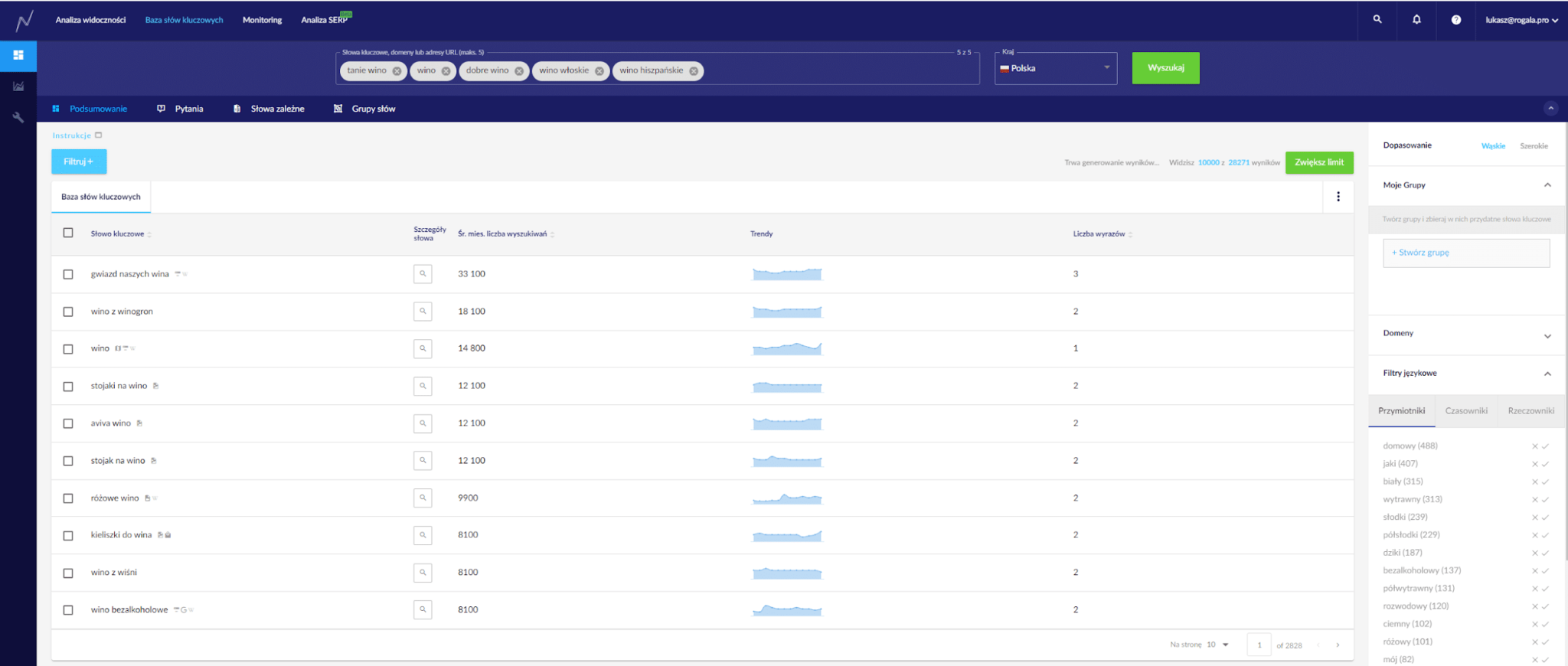
I immediately select the “narrow” matching option, which allows me to focus only on keywords containing one of the words entered as a customer suggestion.
Playing around with language filters will also be a great addition – it’s a good idea to review the suggestions that result from the juxtaposition of adjectives, nouns and verbs. When searching for keywords, they can prove useful in terms of building website traffic.
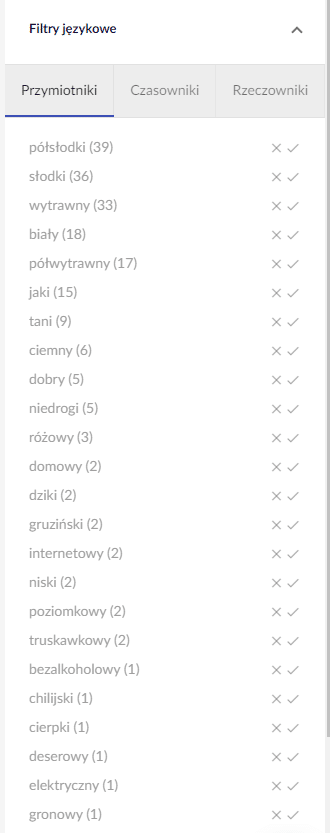
- Step 2: Using knowledge of the competition (business, indicated by the client) and expanding the list with my own research, I check what is the current organic visibility of each competitor’s site and we retrieve a list of keywords for which each domain is visible:
- .
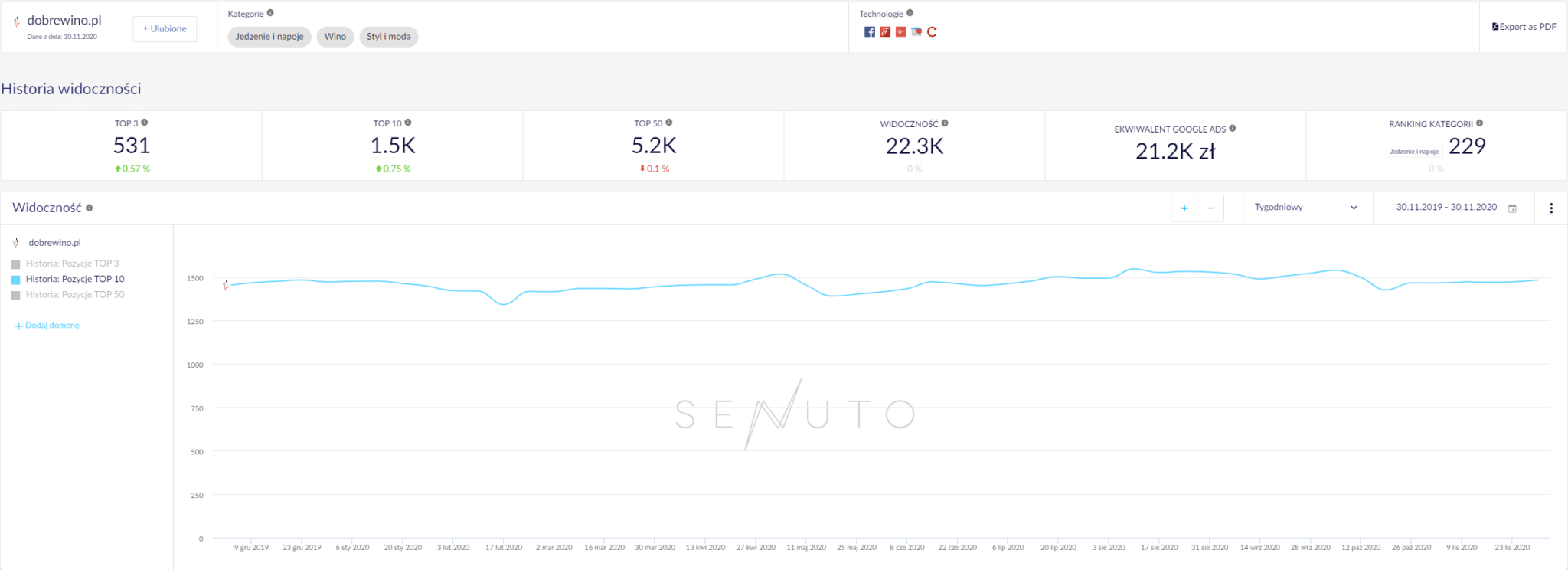

Important: If a page has a distinctive name, and it appears among the list of keywords as a specific keyword, it is a good idea to exclude these words already at the export stage using filters in Senuto:
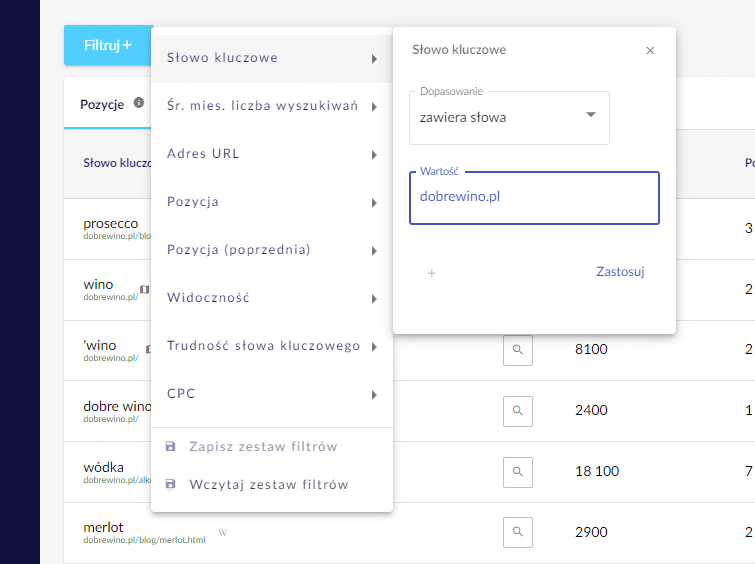 .
.
This will avoid – at least in part – the tedious work of cleaning the list of all keywords at a later stage.
- Step 3: If our domain already has some visibility – we retrieve data on common keywords (this way we have knowledge of what we can realistically compete on) and keyword differences. In this way, we can quickly identify what we should focus on right away (because we have such content), and what for some reason may remain out of our reach (lack of relevant content).The decision in this case is made based on the availability of the offer. For example, someone has as competitors stores that have a much richer assortment. So it is natural that they can fight for a much richer keyword resource. For us, this is a signal that:
- You need to invest in products to have more of them.
- Try to play it off with content, knowing in the back of our minds that this will be beneficial from a traffic standpoint, but won’t necessarily translate into conversions.
.
.
- Step 4: Combine the keyword file into one and remove duplicates. We compile the list of keywords prepared this way with the content of the domain we want to position. The task is labor-intensive, but important, especially when it comes to positioning online stores. What’s next
.
a) As much as possible, we match the keywords with the various pages that exist in the domain.
b) If the potential of the keywords indicates that we should create some additional sub-page, we clearly indicate this in the keyword list. Sometimes it is enough to add a new listing, which at a low cost will allow you to fight for caloric keywords in the search results.
(c) If a keyword shows high traffic potential, but the content on the page is not attractive enough for the competition, we can leave and test the keyword through other channels (such as paid search). Knowing whether a keyword is important or not can come in handy in the future as we develop the content of the pages.
d) The above doesn’t apply to content sites – because even if we don’t have content under something, we can always plow through it with silos that provide the basis for SEO text.
e) It would be a good idea to use the Keyword Grouping tool in Senuto, which will arrange keywords into semantically related silos. In addition to this – randomly – I check the differences in search results for each keyword. If, within a single silo, the search results differ significantly from each other, I consider enveloping the keyword with a dedicated subpage.

- Step 5: We analyze the intent of the keywords and the characteristics of their results (e.g., whether they are in Direct Answer). This way we know whether a keyword will be good for building interest (by solving a problem, showing how to do something) or is strictly conversion-oriented. For new SEO projects, where the goal is to generate conversions as quickly as possible, it is much better to focus on phrases that provide sales rather than general ones that generate organic visibility and traffic.
- Step 6: Using Senuto, identify the characteristics of individual keywords – wherever there are additional snippets (such as Direct Answer), it’s a good idea to take this knowledge into account when recommending optimization of text subpages.
- .
- Domains ranking for any of the keyword groups.
- Accurate URLs on specific positions.
- First, we retrieve information from Ahrefs regarding how many domains and links are pointing to a particular address, in specific positions.
- Information is supplemented by how many links/domains direct to the domain in general.
- We determine the minimum and maximum links based on the list of competitors. Since positioning is work, continuous knowledge of what the average Domain Rating of the links acquired by competitors is, and what the average number of links is, is the first indicator for positioning work.
- Group links by type – the classification that Ahrefs natively provides will help.
Step 4 Download a list of competitors for each word
.
This is a resource-intensive (proxy) task, but essential for a complete picture for effective SEO efforts. Using tools such as Scrapebox, we download for ourselves the top 10 search results for each query.
We divide the list of competitors into two groups:
.
With this breakdown, we can better estimate whether the impact on a page’s position in Google was due to specific links gained to a particular subpage or perhaps the overall link profile (directing to the domain as a whole, rather than individual sections).
Step 5: Check which sections of the site build the most organic visibility with competitors
.
This point is largely dependent on how your competitors have taken care of their information architecture. Nevertheless, it is a mandatory point to check which of the site’s directories generates the largest share of organic traffic. You will do this in the Visibility Analysis in Senuto, in the Sections report.
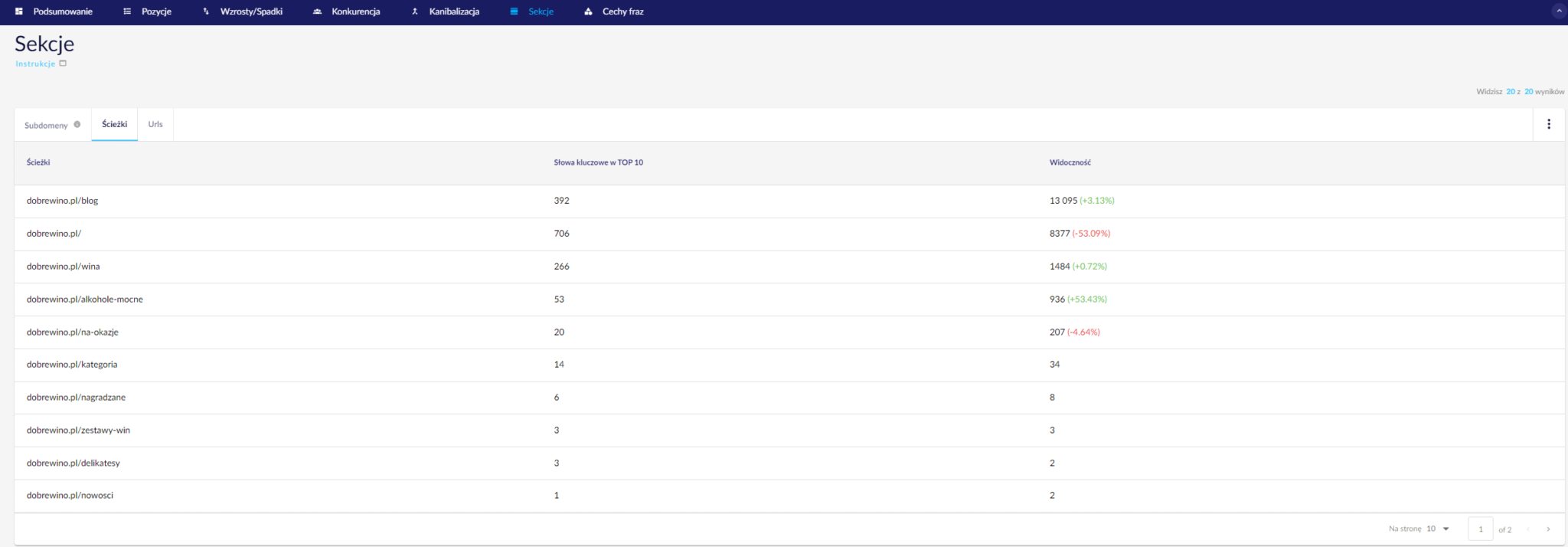 .
.
In the example above, you can see that the penny of visibility (and probably organic traffic) is commanded by the content section located in the /blog/ directory. Going deeper, to specific URLs, we can see which URLs are the most caloric:
 .
.
We export the list, of course, and sort by the number of keywords in the TOP 10:
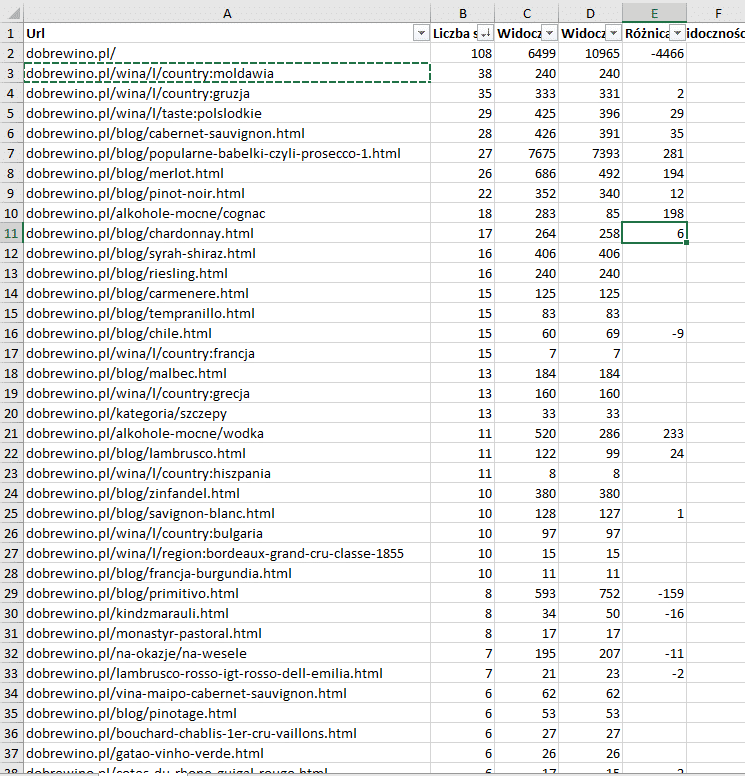
In this way we have information about which sub-pages are mainly involved in building organic traffic of the competition.
Step 6 We analyze backlinks to the site
.
In this case, we do two things:
 .
.
.

If a competitor’s domain is ranking sub-pages high, and no links are pointing to them, then we have a signal regarding the fact that working with onsite and internal linking will be very important.
Note: Competitor link research is also worth expanding with information directly from Google – for example, combining the URL of the linked subpage with exclusions and the site command:
Important: In the final analysis, the key is the number of domains/links directing to the entire domain/subdomain, not the URL to individual subpages.
What do we do with link knowledge?
.
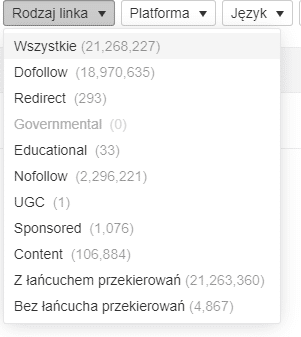 .
.
From the list above, we are mainly interested in those that are follow, nofollow, and devoid of redirect strings.
- We estimate the cost of acquiring similar links by checking their availability on popular content marketing platforms. If there are other links in the link profile, calculating the cost is more difficult, but not impossible. For example, if there are a lot of links to a competitor’s site from foundation/event/conference pages, we can take the cost of the cheapest sponsorship package described on the site as the link cost.
Summary
.
It used to be that doing good SEO analysis of the competition accounted for 50% of success. The budget was planned well, the metrics were readily available and there was nothing left to do but buy and index links.
Since then, the website SEO process has become much more comprehensive. In fact, competitive analysis is worth repeating every quarter – not so much to look for new sites trying to do the same thing as you, but to verify how we’re doing against the competition selected at the beginning. This is especially important when ranking changes are clearly slower than they used to be.
Quarterly competitive analysis also reminds us that SEO is a “long term game”. There are no shortcuts here, and the amount of data we have and can acquire can help us create a sustainable strategy. Its goal is to place us firmly in the category we have chosen.
And while SEO can be unpredictable, steadiness and frequent analysis of your competitors’ actions will allow you to create an effective SEO strategy that is resistant to fluctuations in search results.
 Łukasz Rogala
Łukasz Rogala